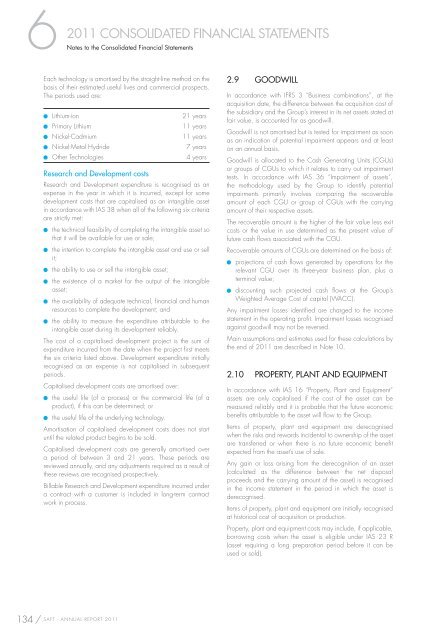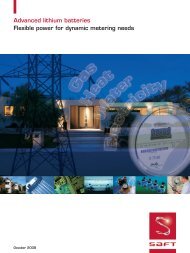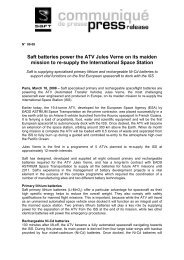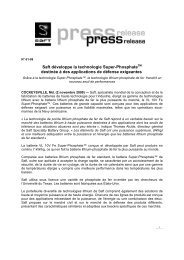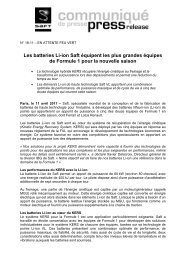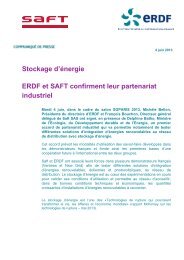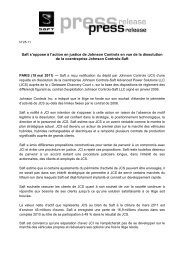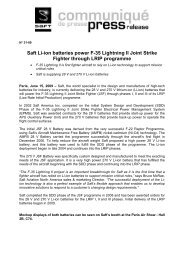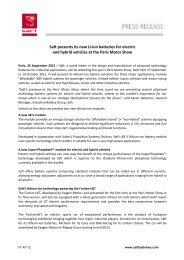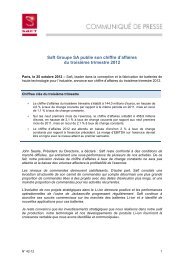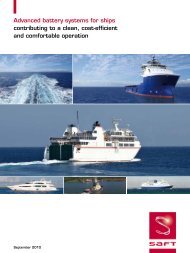ANNUAL REPORT 2011 REGISTRATION DOCUMENT - Saft
ANNUAL REPORT 2011 REGISTRATION DOCUMENT - Saft
ANNUAL REPORT 2011 REGISTRATION DOCUMENT - Saft
You also want an ePaper? Increase the reach of your titles
YUMPU automatically turns print PDFs into web optimized ePapers that Google loves.
6 Notes<br />
<strong>2011</strong> CONSOLIDATED FINANCIAL STATEMENTS<br />
to the Consolidated Financial Statements<br />
Each technology is amortised by the straight-line method on the<br />
basis of their estimated useful lives and commercial prospects.<br />
The periods used are:<br />
� Lithium-ion 21 years<br />
� Primary Lithium 11 years<br />
� Nickel-Cadmium 11 years<br />
� Nickel-Metal Hydride 7 years<br />
� Other Technologies 4 years<br />
Research and Development costs<br />
Research and Development expenditure is recognised as an<br />
expense in the year in which it is incurred, except for some<br />
development costs that are capitalised as an intangible asset<br />
in accordance with IAS 38 when all of the following six criteria<br />
are strictly met:<br />
� the technical feasibility of completing the intangible asset so<br />
that it will be available for use or sale;<br />
� the intention to complete the intangible asset and use or sell<br />
it;<br />
� the ability to use or sell the intangible asset;<br />
� the existence of a market for the output of the intangible<br />
asset;<br />
� the availability of adequate technical, fi nancial and human<br />
resources to complete the development; and<br />
� the ability to measure the expenditure attributable to the<br />
intangible asset during its development reliably.<br />
The cost of a capitalised development project is the sum of<br />
expenditure incurred from the date when the project fi rst meets<br />
the six criteria listed above. Development expenditure initially<br />
recognised as an expense is not capitalised in subsequent<br />
periods.<br />
Capitalised development costs are amortised over:<br />
� the useful life (of a process) or the commercial life (of a<br />
product), if this can be determined; or<br />
� the useful life of the underlying technology.<br />
Amortisation of capitalised development costs does not start<br />
until the related product begins to be sold.<br />
Capitalised development costs are generally amortised over<br />
a period of between 3 and 21 years. These periods are<br />
reviewed annually, and any adjustments required as a result of<br />
these reviews are recognised prospectively.<br />
Billable Research and Development expenditure incurred under<br />
a contract with a customer is included in long-term contract<br />
work in process.<br />
134 / SAFT - <strong>ANNUAL</strong> <strong>REPORT</strong> <strong>2011</strong><br />
2.9 GOODWILL<br />
In accordance with IFRS 3 “Business combinations”, at the<br />
acquisition date, the difference between the acquisition cost of<br />
the subsidiary and the Group’s interest in its net assets stated at<br />
fair value, is accounted for as goodwill.<br />
Goodwill is not amortised but is tested for impairment as soon<br />
as an indication of potential impairment appears and at least<br />
on an annual basis.<br />
Goodwill is allocated to the Cash Generating Units (CGUs)<br />
or groups of CGUs to which it relates to carry out impairment<br />
tests. In accordance with IAS 36 “Impairment of assets”,<br />
the methodology used by the Group to identify potential<br />
impairments primarily involves comparing the recoverable<br />
amount of each CGU or group of CGUs with the carrying<br />
amount of their respective assets.<br />
The recoverable amount is the higher of the fair value less exit<br />
costs or the value in use determined as the present value of<br />
future cash fl ows associated with the CGU.<br />
Recoverable amounts of CGUs are determined on the basis of:<br />
� projections of cash fl ows generated by operations for the<br />
relevant CGU over its three-year business plan, plus a<br />
terminal value;<br />
� discounting such projected cash fl ows at the Group’s<br />
Weighted Average Cost of capital (WACC).<br />
Any impairment losses identifi ed are charged to the income<br />
statement in the operating profi t. Impairment losses recognised<br />
against goodwill may not be reversed.<br />
Main assumptions and estimates used for these calculations by<br />
the end of <strong>2011</strong> are described in Note 10.<br />
2.10 PROPERTY, PLANT AND EQUIPMENT<br />
In accordance with IAS 16 “Property, Plant and Equipment”<br />
assets are only capitalised if the cost of the asset can be<br />
measured reliably and it is probable that the future economic<br />
benefi ts attributable to the asset will fl ow to the Group.<br />
Items of property, plant and equipment are derecognised<br />
when the risks and rewards incidental to ownership of the asset<br />
are transferred or when there is no future economic benefi t<br />
expected from the asset’s use of sale.<br />
Any gain or loss arising from the derecognition of an asset<br />
(calculated as the difference between the net disposal<br />
proceeds and the carrying amount of the asset) is recognised<br />
in the income statement in the period in which the asset is<br />
derecognised.<br />
Items of property, plant and equipment are initially recognised<br />
at historical cost of acquisition or production.<br />
Property, plant and equipment costs may include, if applicable,<br />
borrowing costs when the asset is eligible under IAS 23 R<br />
(asset requiring a long preparation period before it can be<br />
used or sold).


